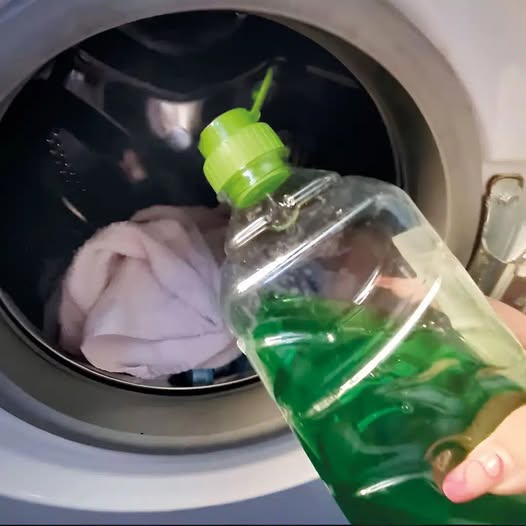ADVERTISEMENT
4. Boosts Laundry Detergent Efficiency
When added in moderation, dish soap can enhance the cleaning power of regular laundry detergent, especially when it comes to breaking down oils and other sticky substances. It can help to lift stains and enhance the washing action, especially if your laundry detergent is low-sudsing or if you’re washing in cold water.
How to Use Dishwashing Liquid in the Washing Machine
While dishwashing liquid can be an excellent addition to your laundry routine, it’s important to use it carefully. Here’s how to do it right:
Step-by-Step Guide:
- Use Sparingly:
Don’t go overboard with dishwashing liquid. A little goes a long way. Using about 1-2 teaspoons of dish soap is more than enough for a standard load. Too much soap can create excessive suds, potentially damaging your washing machine or leaving soap residue on your clothes. - Add It to the Right Compartment:
If you’re using a washing machine with a separate compartment for detergent, you can add the dish soap there. Otherwise, pour it directly into the drum. Just be sure to add it with your laundry detergent, or as an occasional boost, depending on the cleaning need. - Don’t Use It Regularly:
While dish soap can be effective in certain situations, it’s best not to use it every time you do laundry. Stick to your regular laundry detergent most of the time to avoid creating too many suds. Only use dishwashing liquid when you need to clean greasy stains or for an occasional deep clean of the machine. - Be Careful with Delicates:
Dish soap is more powerful than regular detergent, so avoid using it on delicate fabrics such as wool or silk. These fabrics may require a gentler detergent to avoid damage.
When Should You Use Dishwashing Liquid in Your Washing Machine?
Here are a few specific scenarios where adding dishwashing liquid could come in handy:
1. Greasy Stains
When you’ve got stubborn, greasy stains on your clothes (e.g., from cooking oil, butter, or even makeup), dish soap can help break down the oils and make it easier for the washing machine to remove the stains. Apply a small amount of dish soap directly onto the stain before washing for better results.
2. Cleaning the Washing Machine
If your washing machine smells musty or feels dirty, dish soap can help clear out soap scum and residue. Add a small amount to the drum and run an empty cycle to clean the machine. This can help improve the efficiency of your machine and prevent unpleasant odors from transferring to your clothes.
3. Sudsing Problems
If your washing machine isn’t creating enough suds with regular detergent, adding a small amount of dish soap can help. However, be careful not to add too much, as this can create a soap overflow that’s hard to rinse out.
Important Considerations and Tips
✔ Avoid Overuse: Dish soap is meant to clean dishes, not clothes, so you don’t want to overdo it. Excessive suds can damage the washing machine or leave residue on your clothes.
✔ Use in Moderation: Use only small amounts—1-2 teaspoons are all you need. Using too much dish soap can lead to a mess of foam in your washing machine and require multiple rinses.
✔ Do Not Mix with Fabric Softener: When using dish soap, skip the fabric softener as the soap itself can soften the fabric. Mixing the two could cause unwanted residue buildup.
Final Thoughts
While using dishwashing liquid in your washing machine isn’t something you’d do every time, it’s a great trick to have up your sleeve for certain situations. Whether you’re tackling tough stains, cleaning your washing machine, or needing a quick fix when you’re out of laundry detergent, dish soap can be a handy, effective solution. Just remember to use it sparingly and with care to keep your laundry routine running smoothly.
Have you ever tried adding dish soap to your laundry? Let me know how it worked for you!
ADVERTISEMENT
ADVERTISEMENT
